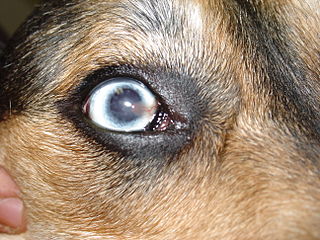Pannus in Dogs
Managing Pannus in Your German Shepherd

Overview
Pannus (chronic superficial keratitis) is an inflammatory disease of the dog’s cornea, or front of the eye, that worsens over time, and it usually affects both eyes at the same time. Scar tissue and blood vessels slowly invade the cornea of the eye from the corner of the eye and can turn it black in severe cases.
Experts believe that it is caused by an unknown
immune response that increases in severity with exposure to high levels
of ultraviolet (UV) sunlight. It is most often seen in middle-aged
German Shepherds, Belgian Tervurens, Siberian Huskies, and Greyhounds,
but it can occur in other breeds of dogs. If left untreated, this disease
can eventually lead to blindness.
Causes
The direct cause of pannus is unknown, but there are a few contributing factors:
1. An increased occurrence in certain breeds indicates a genetic component to the disease.
2. The severity of the disease increases with exposure to UV light and/or high altitudes. It occurs most often in dogs living in the Rocky Mountains and in the Southwest (Arizona, New Mexico, etc.)
3. Chronic superficial keratitis is thought to be an autoimmune disease. This means that a dog’s body response in the wrong way and attacks the tissues of the cornea as something foreign.
4. There is some evidence that irritants in the air and underlying eye problems may also contribute to this disease, such as entropion, or inward-turned eyelids.
Signs and Symptoms
Pannus usually begins at the corner edge of the cornea, advances inward and may extend across the entire eye resulting in blindness in untreated and severe cases. If your dog develops pannus, he may exhibit the following signs and symptoms:
1. Red, blood-shot eyes.
2. Excessive tearing and weeping.
3. A grayish-pink film covering the eyes.
4. Coloring of the cornea, usually dark brown or black.
5. Opaque cloudiness of the eye.
6. Thickening and loss of color of the third eyelids.
7. Although the disease occurs in both eyes, each eye may be at a different stage of the disease.

Diagnosis
A diagnosis of pannus is normally based on clinical symptoms and your dog’s medical history. To make a thorough diagnosis of your dog’s eye condition, your veterinarian will also perform a complete physical exam and eye exam. Additionally, he/she may perform one or more of the following diagnostic tests to rule out any other eye diseases:
(Photo by: Joel Mills)
1. Fluorescent staining of the eye (rules out corneal lacerations and ulcers).
2. A Schirmer Tear Test (measures tear production).
3.
Obtain a sample the cornea and/or lining of the eye (the conjunctiva)
for microscopic examination of corneal or conjunctival cells.
4. Testing of the pressure behind the eyeball [Intraocular pressure testing (IOP)].
Your veterinarian may also recommend certain blood tests to help determine any underlying issues. These may include:
1. Complete blood count (CBC) to check for: anemia, inflammation, and infection.
2. Chemistry tests to check: blood sugar levels and liver, kidney, and pancreatic functions.
3. Infectious disease tests, such as those for Lyme disease, Leptospirosis, and Ehrlichiosis.
4. Bacterial cultures.
5. PCR testing.
Therapy and Disease Management
Unfortunately, there is no cure for pannus at this time. If caught early, the progress of the disease can be suspended and the symptoms can be managed over the long term. However, scarring and discoloration of the cornea usually irreversible. Therapy strategies are implemented to reverse invasion of blood vessels into the corner and to prevent further scarring and pigmentation of the cornea.
Types of therapy:
1. Topical immunotherapy - Immunosuppressant drugs, such as tacrolimus or cyclosporine eye drops or eye ointment may improve symptoms. These can be used in coordination with corticosteroid therapy. In addition, immunosuppressant drugs lower a dog’s natural resistance to certain bacterial infections, so antibiotics are usually given in conjunction with immunotherapy.
2. Corticosteroid therapy - recurrent injections under the conjunctiva of the eyes in conjunction with continuous application of eye drops or eye ointments. This is the main line of defense against progression of the disease. Therapy is usually successful but must be continued lifelong. Even short periods of interrupted therapy, for example 2 to 4 weeks, may cause severe recurrence with devastating effects on the dog’s vision.
3. Surgery - In cases of severe scarring and pigmentation, surgical removal of a surface layer (superficial keratectomy) from the affected eyes may improve vision. Unfortunately, this procedure cannot be repeated and recurrence of the disease is high, so this method remains a last resort.
4. Radiation therapy - Beta irradiation is a last ditch effort to forestall the progress of the disease. This therapy is only used when medicinal and/or surgical therapies have failed.
As with any medication, there are potential side effects. Some drug complications to be aware of are: inammation of the conjunctiva (conjunctivitis), corneal ulceration, and corneal mineralization, just to name a few.Any of these complications may result in permanent blindness , so it is important for the dog owner to be vigilant when his/her dog is undergoing medical treatments for pannus.
The
majority of dogs do very well with topical medications. Some dogs with
more severe cases of pannus may need a referral to a licensed veterinary
ophthalmologist for more intensive treatments.
Long Term Outlook and Prevention
Because there is no cure, pannus is managed with symptom therapies. Treatment must be maintain for the life of the dog and is necessary to maintain vision.
Limited exposure to ultraviolet light is also recommended for long-term control of the disease. Sheltering your dog while outdoors; walking him in the early morning hours, after dusk, or in shaded areas, and keeping him in your house and out of direct sunlight will help keep the disease in check. There are also specialty canine sun goggles that can be used if your dog has to be outdoors for an extended period of time.
In addition to strict adherence to the long term therapies prescribed by your veterinarian, regular veterinary examinations and an immediate visit with the veterinarian when acute symptoms occur are all necessary to keep pannus under control and preserve your dog’s sight.
Sign up for promotions, news, discounts, and the chance to win prizes for you and your German Shepherd
